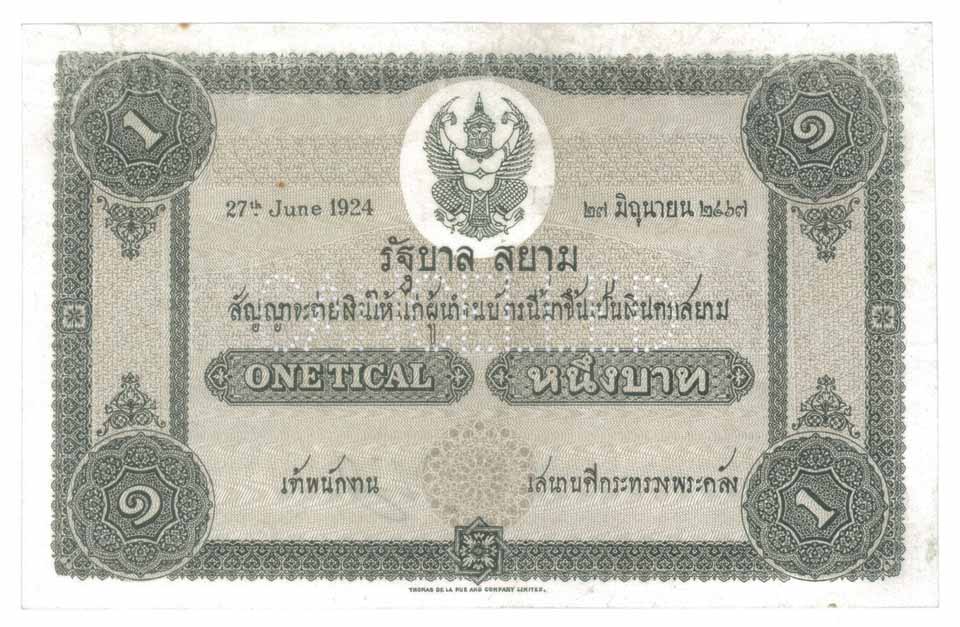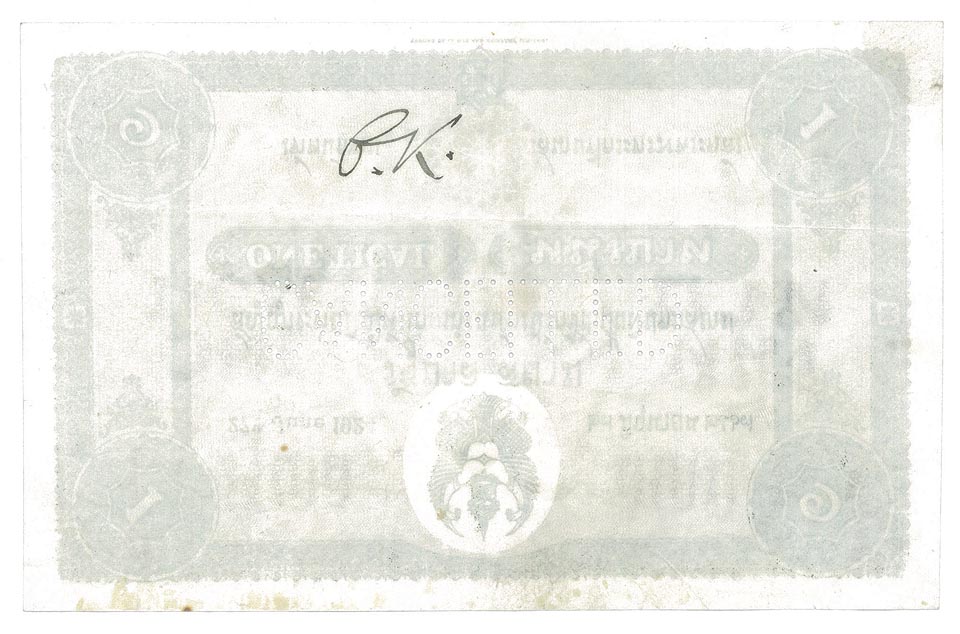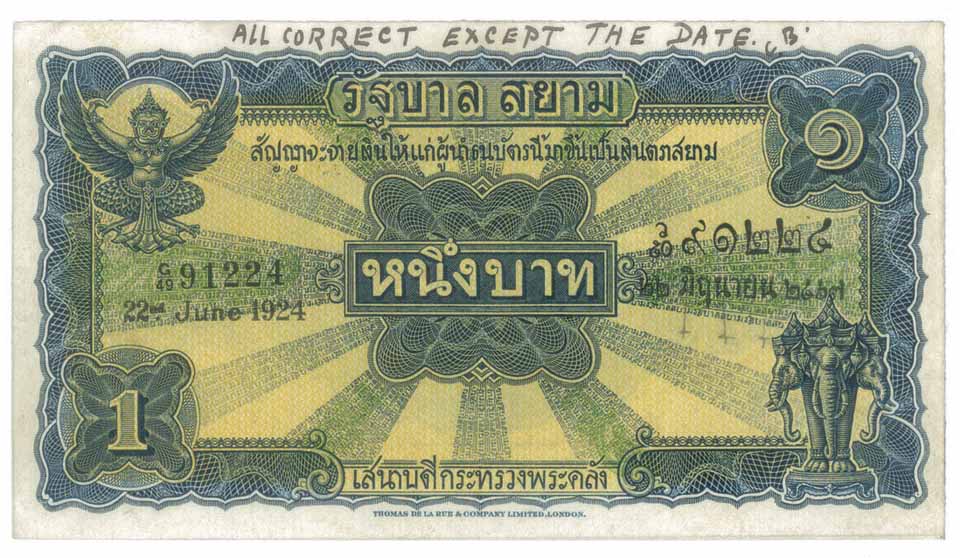

From 1725 the Bank of England printed banknotes on one side only. They were known as uniface banknotes. The last uniface banknote that the Bank of England printed was the £5 note. It was first issued in 1945 and ceased to be legal tender on the 13th March 1961. The First Series Thai Banknotes were also uniface as recommended by Thomas de la Rue & Company Limited London (TdlR) the bank note printer.

On the 22nd December 1917, the Siamese Minister in London, H.E. Phya Sudham Maitri approved the first specimen One Tical/Baht dated 22nd February 1918. On the 1st December 1922 the Secretary of the Siamese Legation invited a representative of TdlR for a meeting on the following Monday between 11 hrs and 12.30 hrs. This was to be in three days’ time. The purpose of the meeting was to discuss small errors in the Siamese spelling on the banknotes First Series.


Authorised Bank Officials signed the Siamese banknotes First Series to the left and to the right by the Minister of the Royal Siamese Treasury. The Charge d‘Affaires at the Siamese Legation in London, Phya Sanpaktich Preecha was of the opinion that some letters in the designations were not correct. This spelling had been used on First Series from when they were announced on 7th September 1902 and the first banknotes were dated 1st April 1902.
This spelling was probably sent to TdlR in 1901 or early 1902 where handwritten “tails” were often added. TdlR engraved these “tails” into the plates while making them for printing. This error was not noticed nor commented on until 1922.






On the 14th of December 1922, TdlR sent a letter enclosing 3 specimens of the One Tical/Baht similar to those already printed and 3 specimens with the Siamese lettering altered as had been verbally discussed. TdlR would print the balance of the order according to the specimen which the Charge d‘Affaires will decide upon. TdlR mentioned that the alteration of the printing plate would be made free of charge and would not cause any delay in the despatch of the banknotes.


After examining the specimen notes, the Charge d’Affaires Phya Sanpaktich Preecha, initialled them as approved and returned the specimen notes on the very same day. This was one of the three notes with the altered spelling. All notes printed after this was to be printed with the new spelling. This is actually a different type than the ones printed before. This type is not mentioned in any of the catalogues I have seen.



The change of the lettering took place sometime on notes dated 8th December 1922 with serial number V/3 and notes dated 18th December 1922 with serial number V/7.
Second last order for One Tical/Baht banknote was made on February 4th, 1924. The order was for five million pieces with the letter “U” in the serial number. The last order of One Tical/Baht banknotes, First Series, was made on October 21st 1924. The order was for 3 million banknotes.
The serial numbers to be used were for U/51 dated 27th June 1924 and serial number U/80 was to be used for the last banknote dated 29th September 1924.
The paper to be used for the order was approved on 4th December 1924. On 12th December, the first One Tical banknote for this order was approved. The first order of 200,000 pieces or if possible 400,000 pieces would be shipped with S.S. “Atsuta Maru” on 3rd January 1925.
In the book “CENTENARY OF THAI BANKNOTE: 1902-2000” published by the Bank of Thailand, it says that the last serial numbers for the One Tical/Baht First Series were U/1 to U/50. According to Somchai Saeng-ngern’S book “Thai Banknotes Catalogue” the last prefix was U/100. The last specimen note was initialled as approved by the Siamese Minister to the United Kingdom H.E. Phya Prabha Karavongse on the 12th December 1924. The last issued One Tical/Baht banknote First Series I have seen does have serial number U/77 and is dated 15th September 1924. In my opinion the last One Tical/Baht First Series does have serial number U/80.


Hand executed artwork for the Second Series One Baht is dated 18th September 1924. The artwork has serial number C/7 and the number 12345. Specimen of the banknote for circulation dated 22nd June 1924 with serial number C/49 and number 91224. The first One Baht Second Series had the prefix A/1 and was dated 1st April 1925. The Serial numbers and dates were approved 6th January 1925. On 11th March, 1925, the Siamese Minister of Finance instructed TdlR to expedite the delivery of all the One Tical/Baht of the First Series before the next consignment of the Second Series of the same value but of the new design was sent. TdlR confirmed on 12th March that the completion of the order for the One Tical/Baht Currency Notes, First Series, would be despatched early next month. The first order for One Baht currency notes, Second Series, were placed 1st December 1923 and announced on 21st July 1925.

On 21st November 1923, H.E. Phya Prabha Karavongse the Siamese Minister to the United Kingdom placed an order on behalf of the Siamese Minister of Finance for 500,000 Ten Tical/Baht banknotes. They were to have the prefix B/71 to B/75. The last 10 Tical/Baht with prefix B/75 was dated 29th January 1924. This is the last order for Siamese Banknotes First Series received by TdlR. The last 5 Tical/Baht had the date 15th January 1920; prefix A/45 and the number 100000. The last date of the 20 Tical/Baht was in 1919. The last date of the 100 Tical/Baht was also in 1919, while all the 1000 Tical/Baht were all dated 7th September 1902, even though they were printed later, as the date did not change before the number had reached 99,999 printed banknotes.


The change of lettering took place only on the One Tical/Baht banknote dated sometime from 8th December to 18th December 1922. No changes took place on the 5-, 20-, 100- and 1000 Baht Tical Banknotes because they were all printed before the change of the lettering took place on the One Tical/Baht. A10 Tical/Baht was initialled as approved by Minister Phya Prabha Karavongse on 11th February 1924 and returned to TdlR with no comments. No changes took place on the lettering on the 10 Tical/Baht banknotes even though they were printed after the change took place on the One Tical/Baht in 1922.
Acknowledgements:
Pratheep S. Malhotra
Vitoon Eurtivong
Suthamma Thana
References:
-The archives of Thomas de la Rue & Company, Limited, London
-Bank of Thailand, “Centenary of Thai Banknotes: 1902 – 2002”
-Somchai Saeng-ngern, “Thai Banknotes Catalogue, Complete and Updated Edition”
-Illustrations of Siamese banknotes from Jan Olav Aamlid collection
Copyright © 2021 All rights reserved by Jan Olav Aamlid
 |
 |
 |





